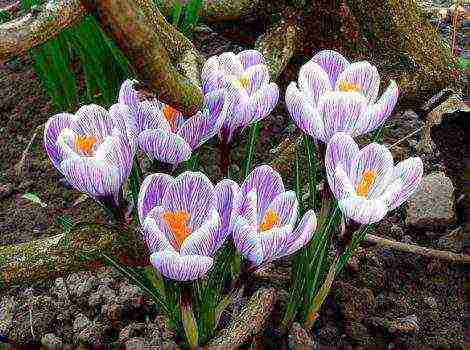Content [show]
Many residents of Russia grow or want to grow grapes on their personal plot. But the climate of most of our country is not very suitable for this culture. By the efforts of breeders all over the world, now there are quite a few varieties that can withstand such difficult conditions. In this article, we will talk specifically about frost-resistant varieties.
Benefits of frost-resistant grape varieties
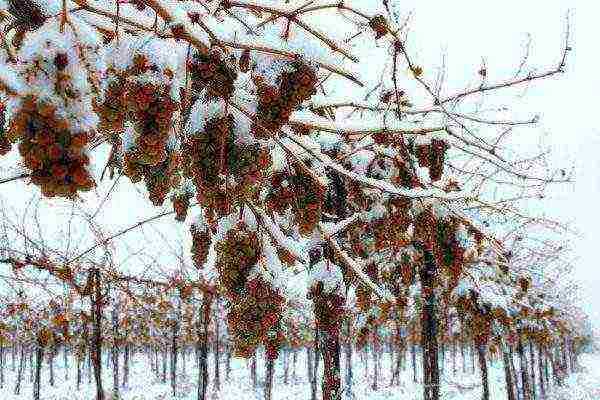 Some frost-resistant vineyards can withstand temperatures down to -27-29 ° С
Some frost-resistant vineyards can withstand temperatures down to -27-29 ° С
The first and main advantage of frost-resistant varieties is clear from the name - these representatives tolerate our harsh winters relatively easily without shelter. Also, the berries are denser and, accordingly, transportable. Winter-hardy varieties are well suited for making wines. What varieties can withstand adverse conditions?
The most frost-resistant for arbors and arches
Lydia
The most beloved and widespread is Lydia. Bred by Williams Prince, a breeder from the USA from the Isabella variety, and received the name Isabella Pink there. It tolerates frost very well. The bunches are small. The berries are predominantly pink. They have an unusual, very pleasant taste. Suitable for arbors and arches.
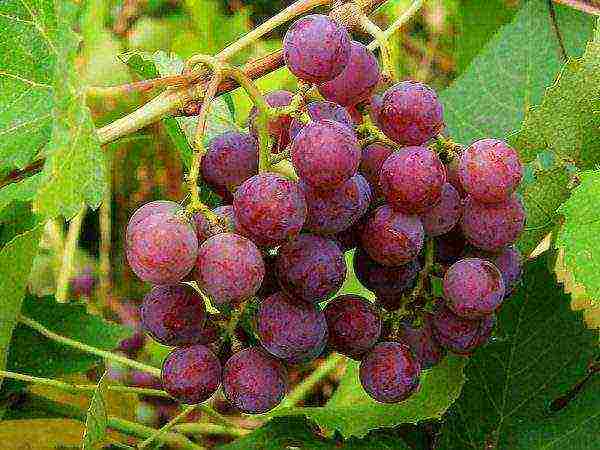 Grape variety Lydia
Grape variety Lydia
Great for wine. But the recipe must be strictly observed. Otherwise, Lydia has the peculiarity of emitting harmful substances if the technology is not followed.
Advantages:
- excellent frost resistance;
- self-pollination;
- resistant to powdery mildew and mildew;
- transportability.
The only significant drawback is the instability to phylloxera.
Aleshenkin
Aleshenkin is an early dessert grape, uncovered. He is also called Alyosha or # 328. It tastes great and looks beautiful - large clusters up to two kilograms, the berries are cone-shaped, yellow-green in color.
 Grape variety Aleshenkin
Grape variety Aleshenkin
Advantages:
- very early;
- does not require special care and special agricultural technology;
- cuttings root well;
- good yield without feeding;
- few seeds in berries;
- great taste;
- the berries stay on the vine at frosts down to -25 ° C.
Flaws:
- the underground part is not resistant to frost;
- berries need a growth stimulant, otherwise peas are likely.
Lady fingers
It has a unique berry shape that looks like women's fingers. Hence the name. The official name is Khusayne Bely. Large sweet berries are arranged in large bunches. The taste is excellent, sweet, with hints of sourness. They are most often used for making raisins, as they are seedless.
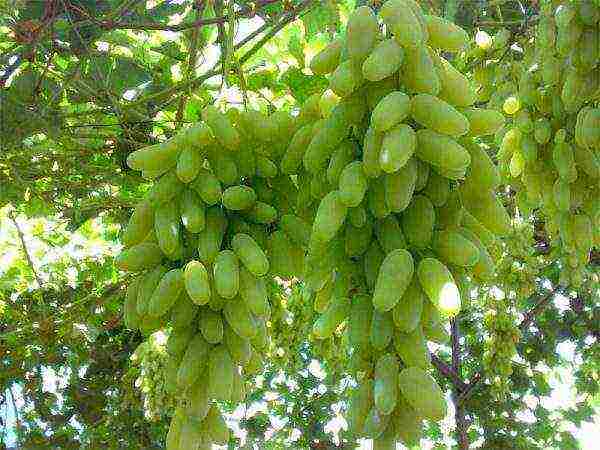 Grapes ladies fingers
Grapes ladies fingers
It is a grape variety native to Central Asia. Very picky about the sun and heat. It has a long ripening period, therefore it is not very suitable for central Russia. It is grown by few winegrowers. With good care and favorable weather, as well as occasional feeding, you can still get a good harvest.
Advantages:
- high productivity;
- strong growth;
- excellent taste;
- lack of bones.
Flaws:
- long ripening period - 130-160 days;
- crop instability over seasons;
- long survival time of cuttings;
- low frost resistance - up to -11 ° С;
- this grape is very fond of wasps and birds;
- extremely susceptible to various diseases - fungus, oidium, powdery mildew.
If all these shortcomings are not scared away from landing, then you should carefully approach the choice of location. It must be protected from drafts, there was a lot of sun. The soil should be light. Groundwater should be deep - more than 2.5 meters. Same for ladies' fingers you need a lot of free space - at least 2-2.5 meters in each direction. If the year turned out to be rainy, then spoiled berries must be removed in time. Otherwise they will suffer healthy fetuses.
Tukay
The Tukai table grape was created at the Research Institute of Viticulture and Winemaking by Ya.I. Potapenko in Novocherkassk. The variety turned out to be unpretentious and frost-resistant. Tukay is loved for its rich harvest and long shelf life of berries, which are very tasty.
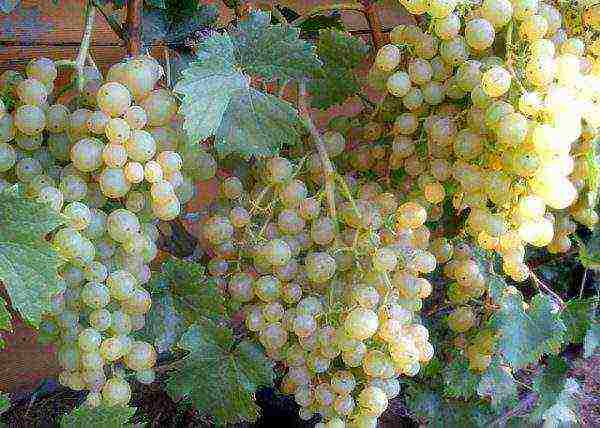 Tukay grapes
Tukay grapes
Advantages:
- early, in July already begins to ripen;
- large bunches - up to 1.5 kilograms;
- fragrant and tasty berries;
- has female and male flowers, hence self-pollinated;
- fruits can be stored until spring, if the temperature regime is observed (from +1 to + 8 ° C).
Flaws:
- needs proper pruning, otherwise the clusters will be small;
- can be affected by a felt mite.
When pruning in the spring, 30-40 eyes are left, and the rest of the shoots are broken off by hand. It is difficult to get rid of the felt mite.
The leaves affected by the parasite must be destroyed, and the plant itself must be treated with colloidal sulfur.
Cardinal
The variety was obtained by crossing grapes by the Queen of Vineyards and Alphonse Lavalle. The brushes are large: length 18-30 cm, width 12-20 cm. Weight - 350-500 g. The berries are large. Their weight reaches nine grams. The color of the peel is violet-red, with a waxy bloom.
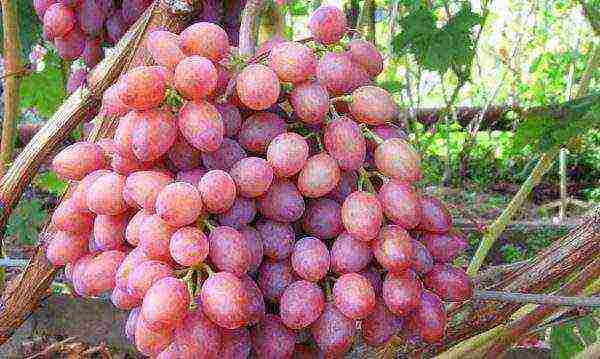 Grape variety Cardinal
Grape variety Cardinal
Cardinal belongs to the early varieties. Ripening time - 105-110 days. Self-pollinated.
The best breeding method for this variety is grafting on the stock.
Advantages:
- excellent taste and attractive appearance;
- large berries;
- suitable for long-term storage;
- good transportability.
Flaws:
- low resistance to diseases and pests;
- shedding of flowers and peas at high humidity;
- the need for careful care;
- poor frost resistance.
Isabel
This variety was bred in the USA by Isabell Gibbs. Hence the name. Isabella, like some other American "gifts" (Colorado potato beetle, ash-leaved maple), turned out to be very tenacious. He does not care about the Epiphany frosts of central Russia. Also, it is practically not affected by any diseases characteristic of grapes.
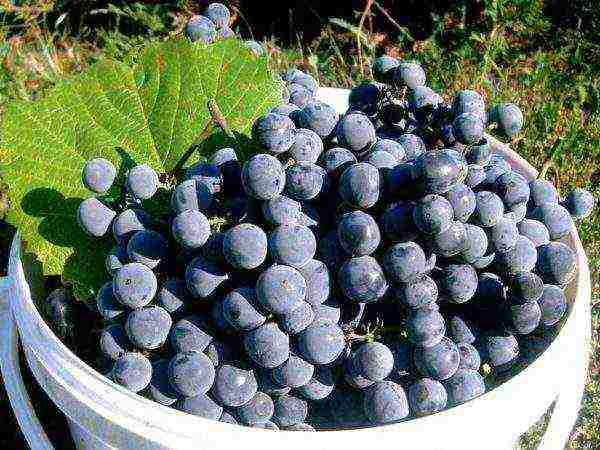 Grape variety Isabella
Grape variety Isabella
At one time there was information that Isabella is harmful, since a lot of methyl alcohol is released during the preparation of wine, but later this information was denied.
Advantages:
- taste qualities;
- low calorie content;
- high productivity;
- unpretentiousness.
Disadvantage for some winegrowers, the late harvest period can be called October-November.
Rylines Pink Seedlis
Of all the varieties described in this article, Rylines Pink Seedlis differs in that it has no seeds. The berries are in the shape of a ball, small, pink with strawberry aroma. The bunches are compact. Harvesting is in mid-September.
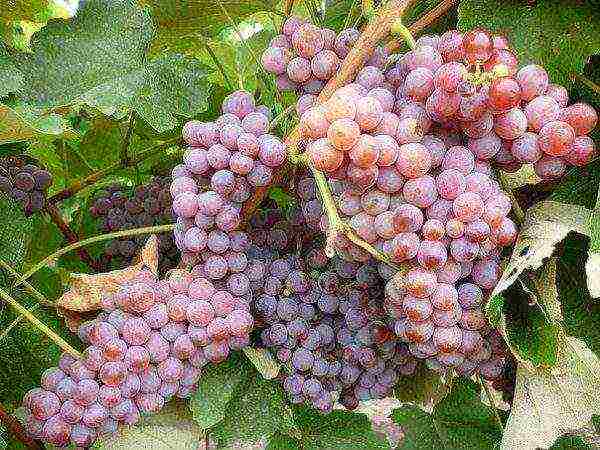 Rylines Pink Seedlis Grape
Rylines Pink Seedlis Grape
Advantages:
- lack of bones;
- high frost resistance;
- rapid growth of the vine;
- very early ripening;
- resistance to fungal diseases;
- increased content of useful microelements (vitamin A, B vitamins, iron and iodine).
Flaws:
- in rainy weather in the ripening phase, the berries are prone to cracking;
- small fruits.
Literally 200 years ago, grapes in Russia were grown only in the southern regions and a little in the center of the country. Now it is grown in the Urals, and in the middle lane it is widespread everywhere. But breeders do not stop at their research. And, rest assured, many wonderful frost-resistant varieties adapted for our country will soon see the light.

When breeding grapes, it is necessary to adhere to many nuances, because this plant is capricious. One of the main requirements is to provide a reliable shelter in the winter. This creates a number of inconveniences, especially if the grapes grow in the country, and not in a nearby area.
In this case, preference should be given to unpretentious frost-resistant grape varieties, the cultivation of which extends to different climatic zones. An overview of the best frost-resistant grapes, as well as the nuances of caring for them, are discussed in our article.
Technical grades
The main difference between technical varieties is their use in winemaking and cooking. Fresh berries, as a rule, are not used, but there are exceptions. Such "generalists" are the most popular in modern breeding, and if they are also resistant to freezing, then such species must be planted on your site. It is from these species that the best wine is obtained, and also used in cooking.
Overview of technical non-covering grape varieties:
- Isabel. Probably the most popular blue grape variety. It is used for making wines at home and on an industrial scale, it is characterized by unpretentious care. The ripening period is 150 - 180 days, the yield is about 70 c / ha. Resistant to typical diseases, it needs support and thinning of the shoots. How to make homemade wine from Isabella grapes yourself is described in detail in the article at the link.
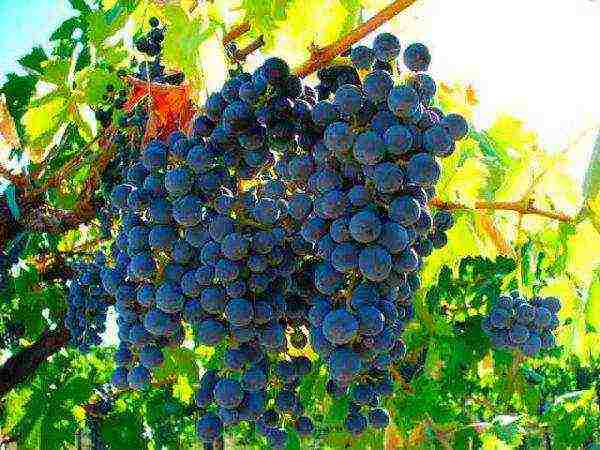
Isabella grape
- Platovsky... Differs in enviable frost resistance - up to -30 degrees. Small pink berries taste good. The ripening period is 110 - 115 days, the fruits do not tolerate transportation well due to the thin peel. You can find out more about Platovsky grapes and see how they look here.
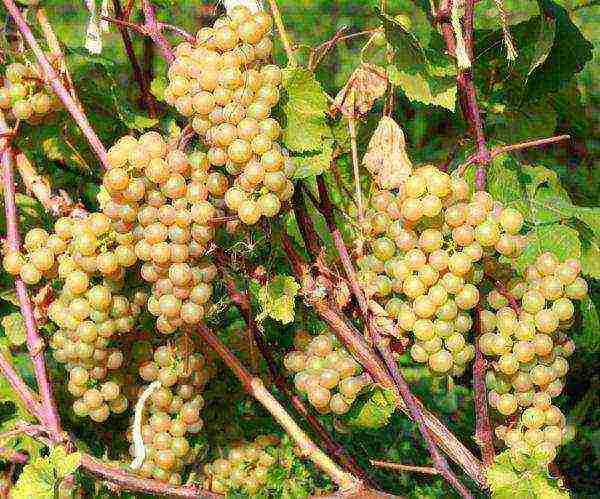
Platovsky
- Alpha... Rather intended for landscaping the site than for harvesting. Average ripening period (135 - 140 days). Withstands cold weather down to -38 degrees, is distinguished by decorative leaves and good covering ability.
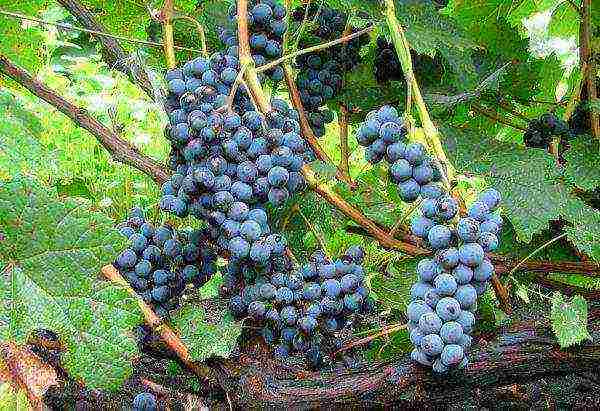
Alpha
- Option... Technical grapes with good taste characteristics. Berries with a dense skin tolerate transportation well. Early ripening and high yields. It can be used fresh due to its well-balanced taste.
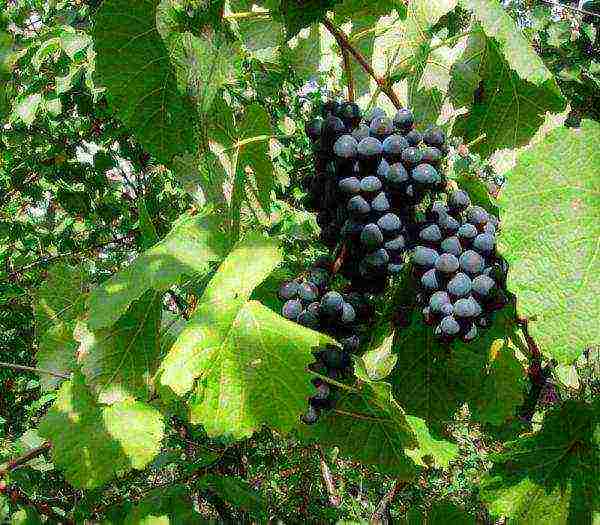
Option
- Marquette. A new generation hybrid that combines excellent taste characteristics and resistance to external threats. Withstands cold snaps up to -38 degrees, high-yielding. The sugar content of the berries is up to 26%, the acidity is 2.9 g / l.

Marquette
- Lydia... Belonging to the Isabella family. Differs in frost resistance up to -25 degrees. A high-yielding variety, often used for landscaping verandas and gazebos. See more photos of Lydia grapes by clicking on the link.
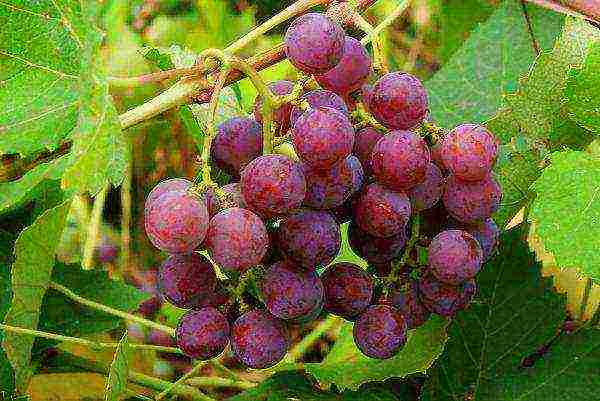
Lydia
- Saperavi north... Highly productive frost-resistant.Small blue berries with a dense skin and juicy pulp. Ripening period - 140 days.

Saperavi north
Of course, the list is far from complete, besides, each grower has his own “favorites” that have proven their invulnerability in practice. Such plants are often used for gardening gazebos and fences. You can find out more about the Saperavi North grape variety from the article at the link.
The video shows frost-resistant grape varieties:
Table varieties
The areas of use of table grape varieties are not so extensive, but they can be consumed fresh. They differ in a more refined taste and aroma. In addition, the berries have a more attractive appearance and tolerate transportation well.
The sugar content of table varieties may be lower than that of technical varieties, but at the same time the acidity is quite satisfactory. This helps to get the most balanced and pleasant taste.
What table varieties are frost-resistant:
- Donskoy agate... Ripening period - 115 - 120 days. The berries are not too sweet (sugar content in the range of 13 - 15%), they are round in shape, the taste is simple. Withstands a drop in temperatures down to -26 degrees, needs to thin out the shoots.
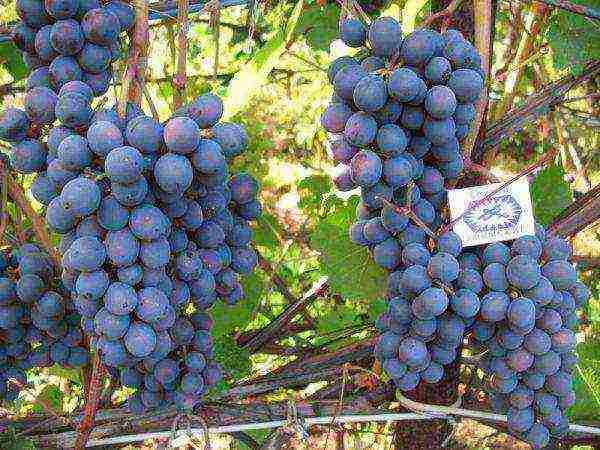
Agate donskoy
- Delight... Excellent taste and productivity, frost resistance up to -25 degrees. The berries are round in shape, medium in size, keep well on the branches without losing marketability. And here you can see a photo of Delight grapes.
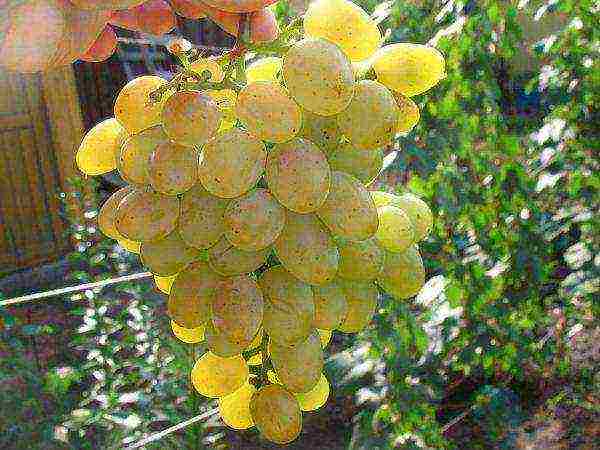
Delight
- The beauty of the north... The growing season is 110 days, frost resistance up to -26 degrees. It is characterized by resistance to diseases, the berries are well transported. The taste is simple, the pulp is juicy.
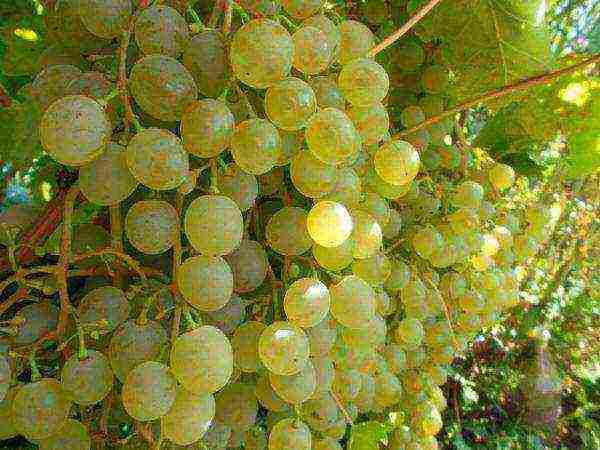
The beauty of the north
- Muromets... Very early, characterized by increased resistance to characteristic diseases. Berries are dark blue in color, withstands transportation well. Sugar content up to 18%, acidity in the norm of 4.4 g / l. It is prone to peas, it is highly productive.

Muromets
- Northern. Early, with good frost resistance (up to -30). The berries are dark blue, medium in size and with a dense skin. It matures in 115 - 120 days and is well suited for transportation.

Northern
- Taiga emerald... Early ripening - up to 120 days. Differs in increased frost resistance (up to -30 degrees) and resistance to diseases. The berries are medium in color, green with a translucent skin. They have a characteristic strawberry aroma.
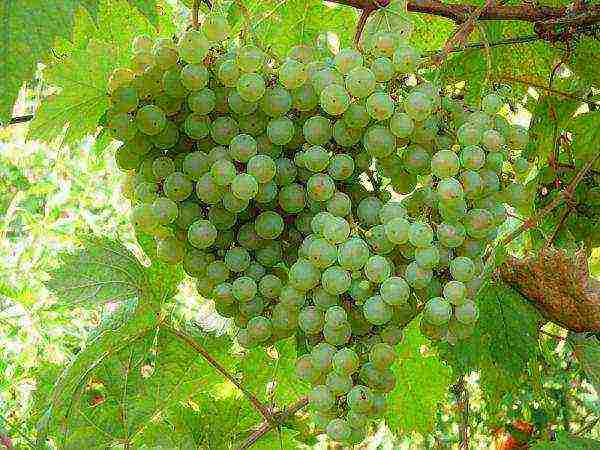
Taiga emerald
- High-yielding canteen... Elongated pink berries. The taste is simple, the resistance to diseases is high. Ripens at 115 - 120 days.

High-yielding canteen
The big advantage of table varieties is the different ripening period of berries. Having chosen the optimal ratio and planting bushes with different early maturity, you can feast on grapes all season.
Which are suitable for Siberia, for the Moscow region
In a more northerly climate, there is a chance to grow any of the varieties described above. The only thing that needs to be foreseen is additional protective cover. The declared frost resistance ranges from -24 to -30 degrees, but, as most winegrowers know, the plant is not afraid of frost, but icing. That is why, even in the south, most types of grapes need to be insulated.
There is one more important nuance - the ripening period. The short summer period means that it is best to use very early and early varieties in order to have time to harvest before the first frost.
The video shows the cultivation of grapes in Siberia:
The following varieties have proven themselves best:
- Early Russian.
- Sharov's riddle.
- Early Bashkir.
- Pinocchio.
- Early Magaracha.
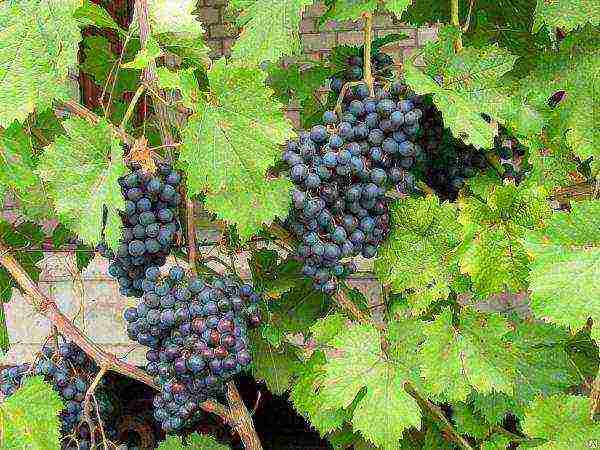
Early Magaracha
- Muscat Katunsky. It is also worth paying attention to the Muscat Delight grapes.
- Tukay.
- Aleshenkin. How the Aleshenkin grapes are planted is indicated in this video.
- Svetlana.
- Solar.
- My lady.
- Amursky.
- Codryanka.
- Hope.
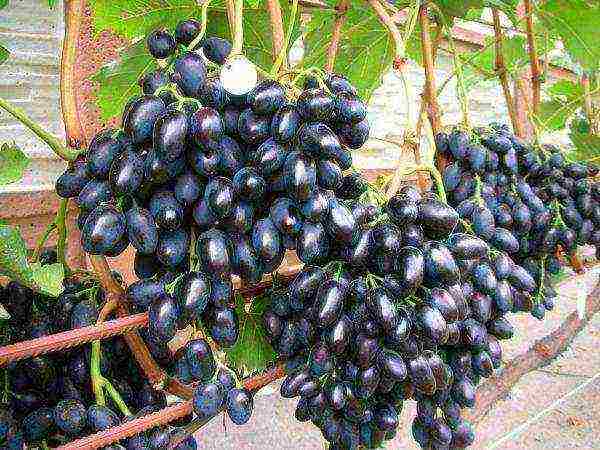
Hope
- Summer Muscat.
- Victoria.And here you can find out more about the description of Victoria strawberries.
- Pink Krainova. It will also be interesting to know more about that. what apples look like Pink pearls.
Frost-hardy grapes are a great choice for any occasion. Technical and table varieties can be used when landscaping a site, so the need for shelter is highly undesirable. In addition, frost-hardy grapes can be grown in unsuitable climatic zones. The best non-covering grape varieties are presented in the information of this article.
Sweet grapes are a concentrate of sun and heat. A hundred years ago, a cultivated fruiting liana grew exclusively in the south, and its clusters were considered exotic even in the middle lane. The technical varieties could be grown in areas with cold winters, but the sweet table varieties remained too tender and could not stand the harsh climate. Only purposeful selection and tenacity of winegrowers made it possible to obtain frost-resistant grapes at the end of the last century. Varieties and hybrids that can tolerate cold are increasing every year, and their taste characteristics are constantly improving. Now the sun berry is grown even in Siberia.
1 History of creation and features of selection
The development of frost-resistant grape varieties began under the guidance of IV Michurin. At the beginning of the 20th century, the first samples appeared that really endured winter frosts and return spring frosts. Russian Concord, Arctic, Buitur, Northern White, Metallichesky - these are varieties representing Michurin selection. Breeder Ya. I. Potapenko initiated the development of disease-resistant and first non-covering varieties: Suvorovets, Stepnyak, Medovy, Festivalny, Saperavi severny.

Northern white
In the 60s of the 20th century, the advancement of viticulture to the north was continued in Orenburg by the famous breeder Shatilov. The most valuable frost-resistant hybrids were obtained by breeding wild vines collected in the Urals and Siberia. This is reflected in the names of the varieties: Amur early, Amur black. The tremendous work of breeders and enthusiasts has led to the fact that grapes in areas with severe winters are now grown on an industrial scale. Moreover, its yield is not inferior to the southern plantations.
To date, zoned non-covering varieties have been created for the Urals, the Far East, Primorye, Non-Black Earth Region. Breeding works are carried out in the Smolensk region, Krasnoyarsk, in Altai. The progenitors of frost-resistant grapes are hybrids of European and American varieties with Amur wild species, which are not only adapted to wintering in frost conditions below -30 ° C, but also need them. They tolerate warm winters with frequent thaws much worse than severe cold.
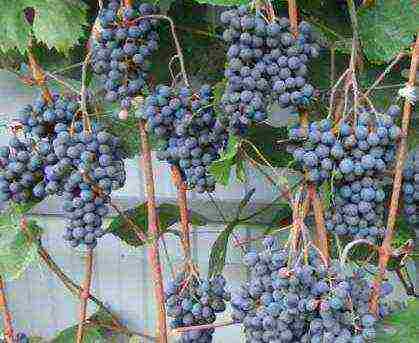
AmurSha (Amur hybrid of Shatilov)
Non-covering forms of culture are relevant when grown in the open ground of the Central strip and the Moscow region. Here, the temperature in winter also regularly drops below -25 ° C. The climatic conditions in such a vast territory are very different, therefore, non-covering hybrids in some areas in winter require protection, and covering hybrids can be cultivated without insulation in others.
Frost-resistant varieties differ from their southern counterparts in their ability to regenerate dead tissues. Barren buds are in the ground and are activated when old roots die, replacing them with new ones. The vigorous growth characteristic of many hybrids allows replacing dead plant parts in one season. New varieties form many ovaries, and their number has to be regulated. The winter hardiness of the bushes suffers from overloading with fruits.
Sugar content of berries, which did not exceed 17% earlier, in recent years in some new varieties reaches 24%. Northern fruits are somewhat inferior to southern ones in size, and their bunch weight is usually less. But breeding work continues and there are more and more large table varieties.
2 The best frost-resistant grape varieties
The grapes can be table and wine. Technical varieties with small berries and small bunches may be of interest as an arched shape for covering large surfaces (gazebos, courtyards, awnings). Most large table varieties still require vines to be removed from supports and sheltered from frost. Therefore, for the formation of a tall bush, winter hardiness is an important indicator, because such a form is more difficult to prepare for winter.
Description of the most popular varieties in temperate climates and the Moscow region:
2.1 Lydia
This is a table-technical variety, an American hybrid of Isabella. It tolerates frosts down to -30 ° C, and is not susceptible to gray mold. Great for covering arches and awnings. The bunch is small, pink berries with a pleasant taste, used in winemaking.

Lydia (Pink Isabella)
2.2 Aleshenkin (No. 328)
Very early, dessert, conditionally covering grapes. Differs in a large bunch (over 1 kg), high yield and excellent taste. The berries are conical, yellow-green, contain few seeds and do not crumble from the bush until frost.
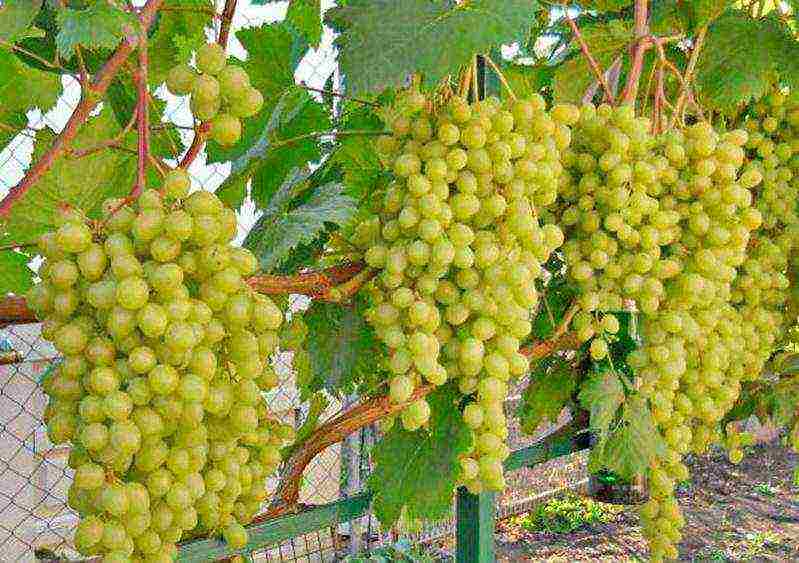
Aleshenkin
2.3 Alpha
Bred in the Far East, but distributed mainly in the Moscow region and Primorye. Differs in violent growth, increased productivity, winters well. Refers to technical varieties, used for landscaping, shoots reach 9 m in length. The bushes are very decorative. The berries have a sugar content of about 19%, are black with an easily peeled skin.
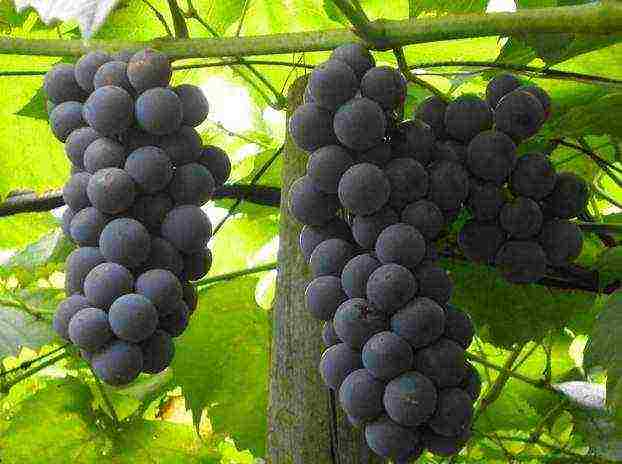
Alpha
2.4 One or Amur breakthrough
The most popular of the Potapenko hybrids. Does not freeze at temperatures of -40 ° C. The vine is powerful, the clusters are dense, dark purple in color with a raspberry tinge. Resistant to rot, diseases, pests. Used in the production of wines and juices.
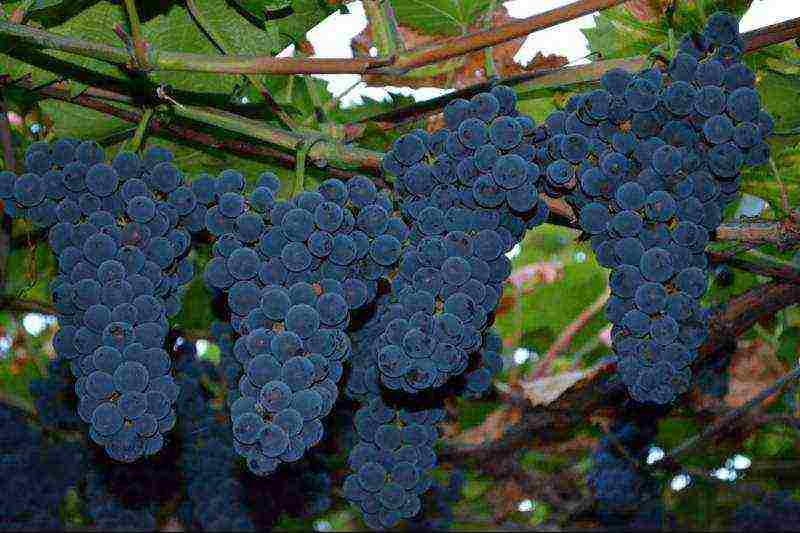
Amur breakthrough (Potapenko-7)
2.5 Crystal
One of the hybrids based on Amur grapes (Hungarian selection). Shows winter hardiness up to -29 ° С, complex-resistant to diseases. The bush is not high, the cluster is conical. Berries with a high sugar content, juicy, left on the bush, ripen, do not crack.
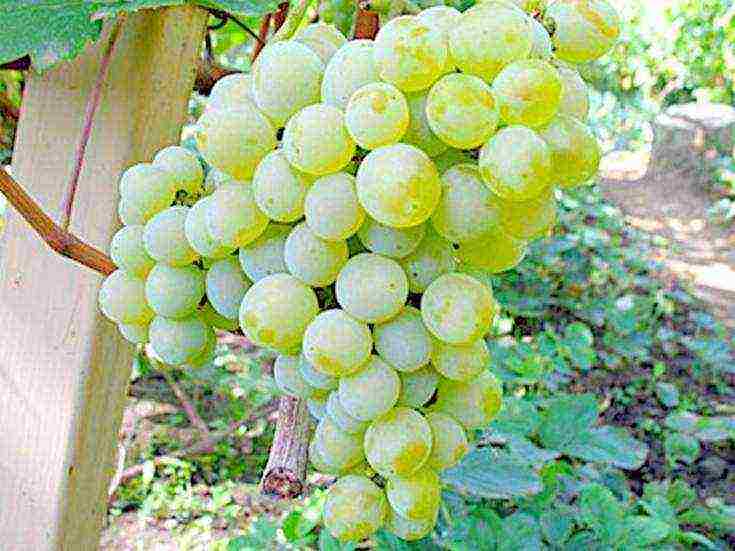
Crystal
2.6 The riddle of Sharov
Bears the name of the famous wine breeder. Does not require shelter down to -34 ° C. The berries are dark blue with a pronounced strawberry aroma and sugar content up to 22%. The yield is average. The variety is self-pollinating, there are no peas in the bunches. The vine is thin, vigorous, ripens quickly. With high humidity, the bushes are susceptible to powdery mildew.
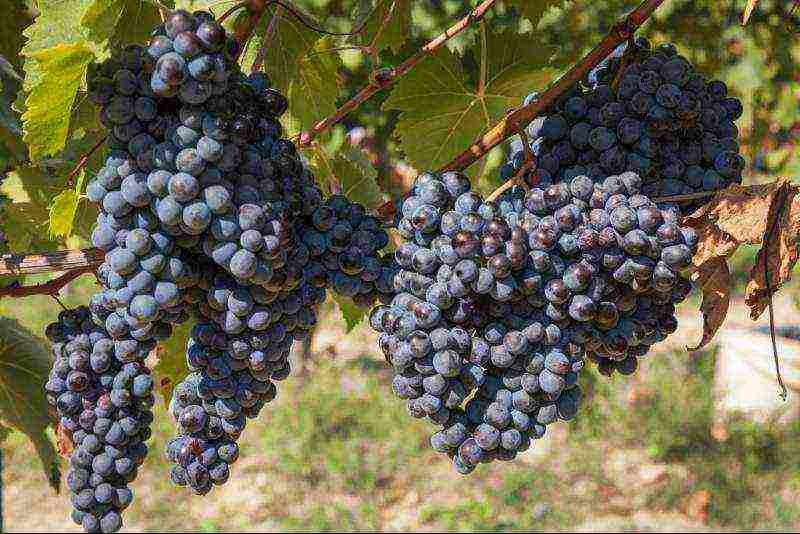
Sharov's riddle
2.7 Skuin 675 or Moscow stable
A complex hybrid that is not susceptible to major grape diseases. A variety for growing in the north, bred in Moscow. The clusters are small with amber fruits, tightly adjacent to each other, with pineapple aroma and notes of nutmeg. A vigorous bush withstands a load of up to 120 eyes. All shoots are capable of bearing fruit, at least 2 clusters are laid on each. It was brought for cultivation to Minnesota (USA), where it is used for the production of high-quality wines.
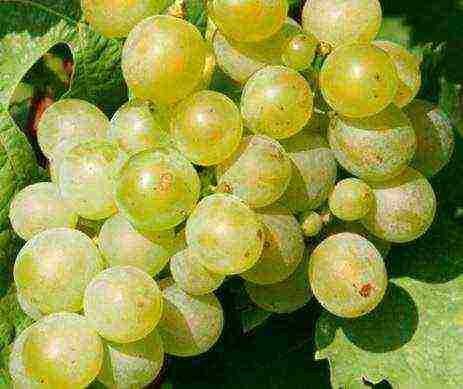
White Muscat Shatilova
2.8 White Muscat (Shatilova)
Possesses very large decorative leaves, clusters are poured up to 1 kg. A vigorous and high-yielding variety. In the middle lane, it ripens in early September. Berries are oval, large, with high taste characteristics. In the regions north of Yekaterinburg, the hybrid should be protected from severe frosts.
Grapes that do not require shelter for the winter in the middle lane can be a shelter for more northern regions. You should carefully study the characteristics of the variety before planting and focus on the lower values of winter temperatures in the region.
3 Highly resistant non-covering hybrids
There are grape hybrids whose bushes are able to withstand particularly low temperatures and at the same time exhibit an accelerated growth rate. The fruits ripen quickly and require less heat. This makes it possible to grow such crops in high-risk areas with harsh winters and unpredictable summer weather.
Recommended winter hardy varieties of American selection:
- 1. Reeline pink seedlings - the most frost-resistant American hybrid (up to -27 ° C). Fruits are pink, pitted, with a labrusca aroma, suitable for drying, making juices, wine and used fresh. The ripening period is very early (105 days). Permissible load - 50 eyes per bush.
- 2. Taiga emerald - a hybrid from the Primorsky Territory, obtained from the American variety Minnesota. Berries are consumed fresh, their sugar content reaches 19.5%. The shoots of this high-yielding variety have time to ripen in a short autumn. Possesses high frost resistance and mildew tolerant.
- 3. Valiant is a super winter-resistant species, the vine can withstand temperatures down to -47 ° С. Early ripening. The berries are black-blue with large seeds and a fruity aroma. Some samples showed a strawberry flavor. Bunches of moderate density, able to stay on the bushes for a long time.
- 4. Triumph is an American table variety with vigorous shoots, tapered long clusters and large oval fruits. Ripens in the second half of August. Able to increase varietal indicators with age.
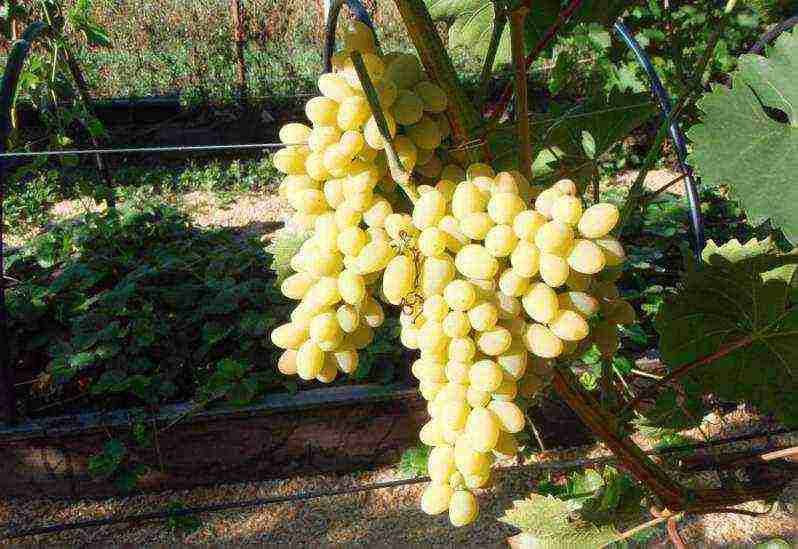
Triumph
Non-covering varieties of American origin also include: Kay Gray, Moore Earley, Venus. When bred, Euro-American hybrids acquired resistance to phylloxera, which favorably distinguishes them when choosing a variety for planting. Frost resistance in such varieties is slightly lower - from -30 to -34 ° C, but tolerance has been achieved to almost all diseases that annoy the vineyards.
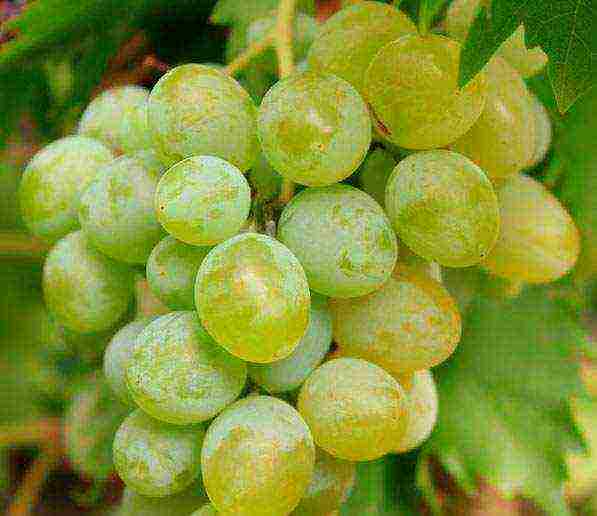
Kay Gray grapes
Some European frost-hardy species:
- Lando Noir;
- Louise Swenson;
- Somerset Seedlis;
- Prairie Style.
They are not inferior in quality, and in some positions even surpass their foreign relatives, grape varieties bred in Russia from local relics by selection and selection. Small-fruited Amur liana has turned in the hands of breeders into many varieties that simultaneously possess frost resistance, excellent presentation and high taste.
Amur grapes grown, for example, in the Smolensk region, shows a sugar content of 21.4%. His vine tolerates frosts below -40 ° C during a snowless period in an open vineyard.
Recommended varieties for the northern regions and the Far East:
- Vaskovsky hybrids (No. 5 and No. 6);
- Shatilov's hybrids (from 2 to 15);
- Latvian variety Gulya;
- Khasansky Bousa and Khasansky sweet;
- Siberian cherry;
- Early Bashkir.
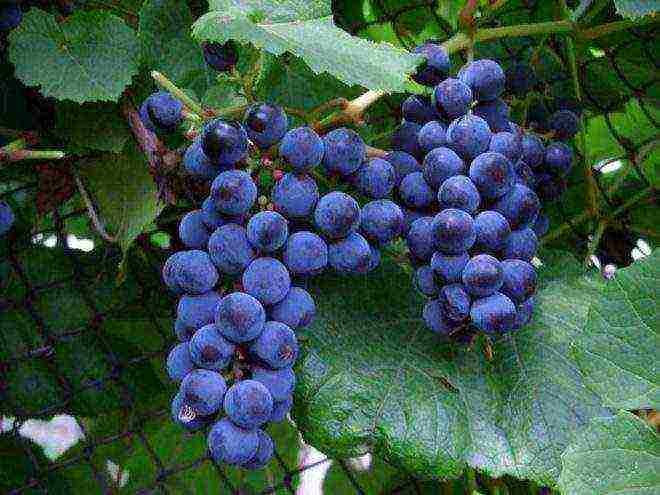
Khasansky Bousa
Many other varieties for each region are regionalized or obtained through selection by amateur winegrowers and specialized institutes. But the high characteristics of the hybrid still do not guarantee successful cultivation and a bountiful harvest. Along with the unique qualities, northern grapes are distinguished by the principles of care, pruning and other features.
4 Features of growing non-covering varieties
The resistance of the vine, even in the most frost-resistant specimens, does not appear immediately. For the first two years, the bush should be removed from the supports and laid on the ground for shelter before cold weather. After the third season, one lash is left uncovered for testing. If the test is passed and the vine has wintered successfully, the bush can hibernate without insulation. Because of this feature, all resistant varieties are considered conditionally non-covering.
There are several more features in agricultural technology:
- 1. Northern grapes have a high yield. If you do not adjust the fullness of the bush, then the yield will be large, and the winter hardiness of the plant will decrease. The vine will not have time to ripen, and the bush may freeze out.
- 2. More difficult than frost, such hybrids tolerate thaws. With a prolonged increase in temperature, the plant begins to vegetate and loses its varietal resistance to cold. A shrub accustomed to frost at -30 ° C can die at -12 ° C.
- 3. The cultivars are characterized by wild growth.Bushes require regular pruning, removal of stepchildren, thinning and pinching of the lashes. Otherwise, the grapes begin to "degenerate" and lose varietal characteristics. The abundance of branches in summer inhibits the ripening of bunches.
- 4. Pollination is an important stage in the establishment of the crop. Before buying seedlings, you should clarify whether the plant needs pollinators and what kind. Some hybrids require help during flowering - spraying, cross-pollination, shaking off the scaly caps.
The North of Russia has unique data for growing grapes. Already starting from the Urals, during the winter there are no pests in the soil that can infect shrubs. During selection, frost-resistant varieties received increased resistance to the main grape diseases: mildew, oidium, phylloxera, rot and fungal infections. Therefore, chemical treatments of vineyards can be minimized.
Experienced growers are advised to exclude mineral mixtures from dressings and use organic matter. Thus, the grown crop will be environmentally friendly and safe, which cannot be achieved in the south with an abundance of insects and diseases.
Many gardeners have learned how to grow grapes in the Far East, in the Urals, in Siberia, and the Moscow region has long been considered a risky region for this crop. Every year the collection of frost-resistant and ultra-early varieties for any climate is replenished. In many areas previously inaccessible to the southern plant, it is now cultivated in hectares. A further goal of selfless breeders is large table varieties that, without shelter, will be able to survive even more severe winters and give their owners a sweet and fragrant harvest.
Grapes are by nature a thermophilic culture, originating from countries with a favorable climate. However, amateur winegrowers want to grow sunny berries in the conditions of central Russia, the Urals, Siberia and the Far East. For this, grape varieties with increased frost resistance have been developed. It is not difficult to obtain generous yields of sweet berries in harsh conditions, but for this it is useful to know the intricacies of growing and caring for grapes.
The concept of frost resistance of a grape variety
In reference books on viticulture, the definition of the frost resistance of the variety is given. Frost resistance of grapes is the ability of its vegetative system in winter to withstand for a short time a drop in temperature to the values specified in the characteristics of the variety, without damage or with minimal damage to the eyes of one-year-old shoot. In short, this is the resistance of the variety to critical negative temperatures. This means that at a certain low temperature those parts of the plant that further determine the fruiting and yield of the crop do not die. With a sharp drop in air temperature in winter, the buds (eyes) of the vine first freeze out, then the bark and cambium of the plant's wood are damaged. This applies primarily to young one- and two-year-old seedlings. Such a characteristic as frost resistance is determined for each grape variety empirically. The degree of frost resistance is derived on the basis of the results of long-term observations of the development of plants under the conditions of the experimental station. This indicator is the nominal (standard) value. In real conditions, sometimes significantly different from favorable, the frost resistance of grapes is lower than the declared one.
Table: grouping of grape varieties according to the degree of frost resistance
At critical low temperatures, freezing of up to 50% of fruit buds (eyes) is possible. A further decrease in temperature increases this figure to 80%. Frost damage to annual seedlings, in which not only generative buds freeze, but also wood, causes the death of the entire bush. The index of frost resistance of the variety is of fundamental importance when growing grapes in a non-covering culture. As a rule, these are high-standard formations in the form of altans, high hedges, arches and gazebos, where the sleeves of grapes are not removed from the supports, but hibernate in the open.
In contrast to frost resistance (resistance of fruit plants to critical negative temperatures), winter hardiness characterizes their resistance to the sum of unfavorable factors (including low temperatures) in winter. As a rule, most of the fruit crops exhibiting high frost resistance are at the same time highly frost resistant.
Features of growing frost-resistant varieties
The success of growing grapes in certain climatic conditions critically depends on the temperature regime of the region. It is known that the need for the amount of heat and sunny days for different grape varieties is significantly different. Low freezing temperatures sharply limit the use of varieties that are especially demanding for heat. When grape bushes are damaged by severe frosts, their mass death occurs. The highest degree of frost resistance is manifested in plants during deep winter dormancy. With the transition at the end of winter from organic dormancy to forced, and then by the beginning of the growing season, the frost resistance of the grapes decreases. Returning spring frosts affect the flower buds that are most sensitive to cold. The minimum probability of frost damage to grapes is during the period of blooming and flowering. The vine is the most resistant to frost. Unlike flower buds and grape roots, it is able to withstand even twenty-degree frosts. If, as a result of very severe cold weather, the vine is frozen, in the spring new replacement shoots grow from the dormant buds and the bush is restored within one growing season.
Video: choosing grape varieties - advice for novice gardeners
Caring for grapes of frost-resistant varieties is basically the same as caring for ordinary varieties. It consists in loosening the soil directly under the bushes and in the aisles, regular watering, weed control, correct formation and timely pruning of bushes, prevention of fungal diseases. The choice of the variety that is most suitable for specific climatic conditions, the time and place of planting grape seedlings is of decisive importance. In areas where cover varieties are grown in winter, grapes must be covered with suitable materials, which provides protection against frost damage and as a result of sudden winter thaws. Seedlings of frost-resistant grapes up to four years of age are subject to compulsory shelter for the winter, regardless of whether it is a covering variety or not.
Video: snow shelter of grape bushes
Despite the fact that frost-resistant varieties are able to withstand severe frosts, they require some preparation for winter. The grapes removed from the trellises should be laid on the ground, or better - on boards, roofing felt or wooden shields. Then the sleeves and vines are pressed down with coniferous spruce branches, pieces of foam, linoleum and covered with agrofibre folded in several layers, and on top with a film to protect against moisture. Under a snowdrift, the grapes covered in this way will winter safely even in severe frosts and icing. It has been experimentally established that 10 cm of the height of a snowdrift keeps grapes at ten degrees above zero.
Usually, around the end of October, I remove my grapes from the trellises, prune them, always leaving 3-4 large vines, and on each one - 1 replacement knot and 1 fruiting vine. Weak and crooked shoots coming from the root, I remove, and the shoots that have fruited in the current year are also cut to the fruiting vine, without leaving a hemp. Old and gnarled shoots, with cracked bark, coming from the root, I cut out at the base.After I cut all the grapes, I lay them on the ground, pressing the vines with sticks so that they do not spring. So he waits until spring.
Fruiting grapes exclusively on the growth of the current year, annual ripe stems - vines. Therefore, annual shoots are the basis of the harvest. Seedlings of the second year in early spring must be pruned so that the skeletal arms of the bush begin to form. Starting from the age of three, in the spring, grape shoots opened after winter are tied up on pre-prepared supports - trellises. The grape bushes of the covering varieties are cut in two stages: in the fall - before the bushes are sheltered before the onset of frost and in the spring - after the bushes open before the buds open and the growing season begins. When pruning, such a number of eyes (future fruitful shoots) are left, which provides a high yield without reducing the strength of the bush. The number of eyes remaining after trimming is called the load of the bush.
Video: pruning a young bush of grapes
Pruning grapes of non-covering varieties has its own characteristics: the bushes are pruned mainly in the autumn-winter period, two to three weeks after the leaves fall, and continue throughout the winter at zero or positive (+ 3-5 ° C) temperatures until the buds begin to open. Sleeves of non-covering varieties are fixed on arches, gazebos, walls of buildings.
Early frost-resistant grape varieties
In the southern regions, grapes can ripen without loss until mid-autumn. When growing this crop in areas with a fairly short warm period and the possibility of early autumn frosts, the time from flowering to full ripening of the crop should be minimized. Therefore, the varieties zoned for the Central, North-Western and Ural regions have a short growing season, increased frost resistance and are classified as very early and early. These varieties include the grapes Krasa Severa, Muromets, Timur, Agat Donskoy, Talisman, Kodryanka and a number of others.
Table: early varieties of frost-resistant grapes
Most early varieties are characterized by:
- high productivity of bushes;
- good fruit taste;
- self-pollination (due to bisexual flowers);
- full maturity of the vine;
- versatility of use (fresh and in juices, drinks, wines).
The grapes of the Talisman variety have the same type of flowers (female), therefore, for pollination, it needs the appropriate pollinator varieties.
Photo gallery: features of various early grape varieties
Despite the great similarity in characteristics, the early varieties have a number of differences. For example, the high content of folic acid in berries made Krasa Severa grapes medicinal fame. Grapes also differ in resistance to fungal diseases and the need for protection in the winter. Varieties that are susceptible to mildew or powdery mildew must be treated with fungicides during the growing season. The timing and frequency of processing depend on the specific grape variety.
Given the relatively high degree of frost resistance, in areas south of the Central Black Earth Zone, grapes can be grown in non-sheltered culture. However, in the event of a winter with little snow or very severe frosts, the bushes need shelter to avoid freezing of flower buds and wood. This is especially true for young plants in which the thickness of the tree cover of the vines and arms is insufficient.
Video: early varieties for the Moscow region and the North-West region
Grape varieties of increased frost resistance
Thanks to active selection work, the zone of growing frost-resistant grapes has significantly expanded towards the northern regions, and now the border of its cultivation runs along the line Smolensk-Tver-Ivanovo-Kazan-Ufa. The most frost-resistant varieties are Severny Early, Platovsky, Kristall, Zilga, Korinka Russian, Pamyat Dombkovskaya. The grapes of these varieties can withstand frosts from -28 ° C to -32 ° C.However, it should be borne in mind that when grown in more northern regions, the bushes require good shelter for the winter. In areas with mild winters, in the absence of sharp fluctuations in temperature during the winter, grapes can be left without shelter or a very light shelter can be made.
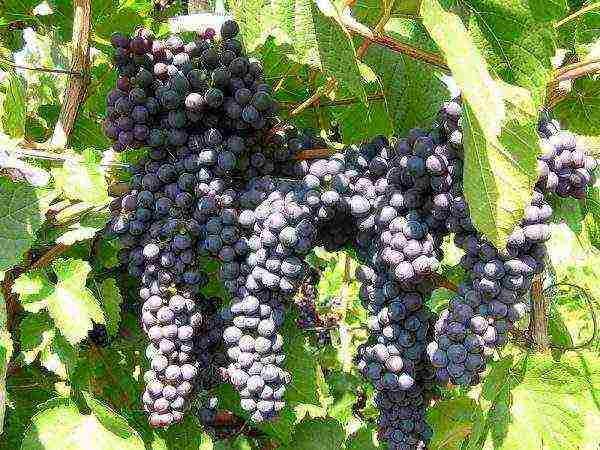
The grapes Pamyat Dombkovskaya are recommended for cultivation in private farms as a high-yielding table variety with berries of a wonderful harmonious taste, collected in large beautiful bunches weighing up to 370 g
Table variety Pamyat Dombkovskaya belongs to the raisin (seedless) group. The grapes are very early ripening, the growing season is 110-115 days. The bushes are vigorous, have bisexual flowers and are self-pollinated. The yield of the variety is very high, on average 8.5–9 kg / bush. In the varietal characteristics, frost resistance is declared up to minus twenty-eight degrees, however, it is recommended to cover the grapes for the winter. Increased resistance to diseases and pests is one of the main advantages of the variety. The disadvantages include the periodic overload of bunches of bushes. This causes the berries to grind and reduce their juiciness. All of these qualities make it possible to grow Memory Dombkovskaya grapes throughout Russia.
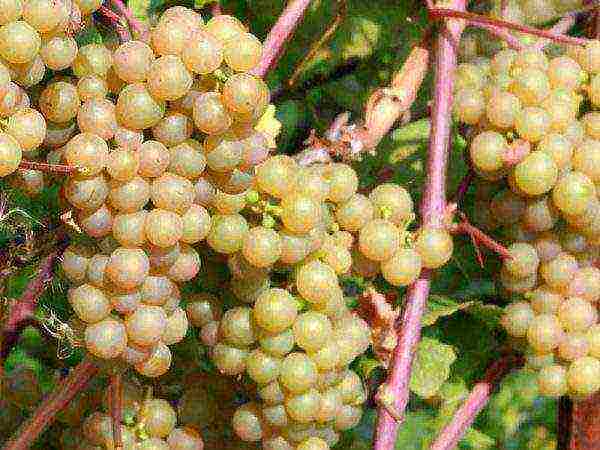
Platovsky grapes are known primarily for their unpretentious cultivation and gives consistently good yields even under adverse weather conditions.
The main characteristics of the Platovsky grape variety:
- Mainly grown as a technical variety.
- The crop ripens quickly, in 110-115 days.
- The berries are very juicy, with a harmonious taste and high sugar content (21.3%).
- The yield is from 3.5 to 5 kg per bush.
- The vigor of the bushes is average, the variety is self-pollinated.
- It has a high frost resistance (-29 ° C), therefore, in the North Caucasus region, it is often grown in an open culture.
- Has increased resistance to fungal diseases and immunity to phylloxera.
- One of the best varieties for making high quality dry wines.
Video: Grape variety Platovsky
Grape harvest Early TSKHA ripens very early, within 110-115 days. The grapes of this variety do not stand out for their special size: on medium-sized bushes of average weight, berries (about 2 g) are collected in medium-sized bunches (weight 75–90 g). Usually one bush gives about 3.5 kg of fruit. The flowers are bisexual, so there is no need for additional pollination. The variety has a low (at the level of 40-60%) resistance to fungal diseases and pests (affected by spider mites). Frost resistance of grapes is regulated down to -28 ° C. But given that the variety has a permit for cultivation in all regions of the Russian Federation, in the northern regions, light shelter is required for the winter.

Due to the good taste of berries with the presence of pineapple aroma, the Early TSKhA variety is used as a universal variety, for fresh consumption and for processing into juices, compotes and wines
Noteworthy are the grape varieties that successfully grow and bear fruit in Siberia: Pearl Saba, Rusven, Amirkhan, Aleshenkin, Arcadia. And this is not a complete list of varieties that mature in a harsh climate with short summers and long, very cold winters. Today, grapes, until recently considered a purely southern culture, have firmly taken their place in the plots of Siberian gardeners.
Video: features of frost-resistant varieties for Siberia
Considering the specific conditions of Siberia, very early and early varieties are used for planting. Agrotechnology for growing grapes in this region has its own characteristics. Despite the high winter and frost resistance, the bushes in winter can be damaged by frost. Therefore, grapes in Siberian conditions are grown either in trenches or on high ridges, with the obligatory insulation of boles and roots. However, such extreme conditions have a positive side: neither diseases nor pests affect the grapes. Consequently, no treatment with pesticides is required and the crop grows environmentally friendly. Most of these grape varieties have very tasty berries, fragrant and beautiful, collected in large, heavy bunches. Thanks to the varietal characteristics, the vine has time to ripen and the grapes leave safely in the winter.
Non-covering grape varieties
Grape varieties, the main characteristic of which is very high frost resistance (up to -40 ° C), are called uncovered or arbor. Most of these varieties are immune to mildew, powdery mildew and gray mold. The berries are inferior in size and taste to the fruits of the covering (European) varieties, but this disadvantage is compensated by the ability to use the bushes to shade arbors and resting areas. The main purpose of uncovered grape varieties is technical, for the production of wine and drinks.

Thanks to the intense color of the berries and the high sugar content, high-quality wines are made from the grapes of this variety.
The Saperavi Severny variety is technical and is used mainly in winemaking. The ripening period of the crop is late, late September-early October. A distinctive feature of the variety - ripe brushes do not crumble for 20-25 days. The berries are very juicy, with a high sugar content (17–20%), but small, weighing 0.8–1.2 g. The taste of the berries is specific "isable", which is appreciated in wine making. The clusters are small, the average weight of one brush is about 100 grams. Having bisexual flowers, the variety is self-pollinated. In non-sheltering culture, the branches and vines of the Severny Saperavi are able to withstand frosts down to -30 ° C.
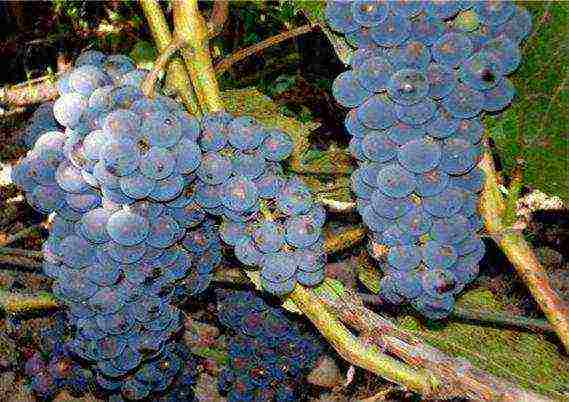
A pleasant strawberry hue in the taste of Alpha grapes and balanced acidity make it indispensable for the production of dry wines
Alpha grapes are known as one of the best in winemaking. Small fruits of sour taste are collected in clusters of medium size and weight (up to 200 g). On tall bushes, the crop ripens 140-145 days after flowering. The variety is self-fertile, practically not damaged by fungal diseases and pests. High frost resistance up to -40 ° C allows growing grapes of this variety without shelter in the form of arches and arbors, for wall decoration. Even slightly frozen berries do not lose their taste and presentation.
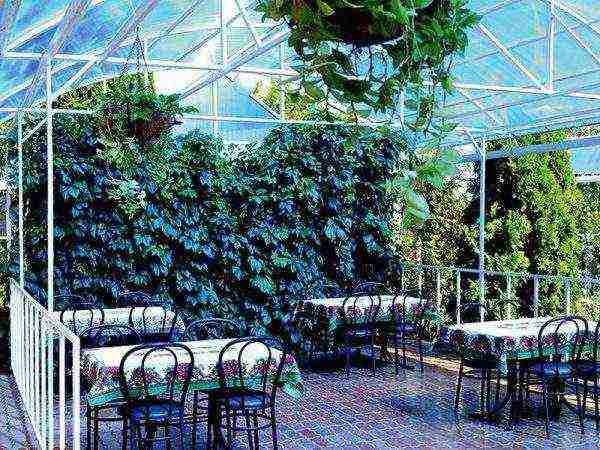
Tall vigor and very good frost resistance in combination with an interesting taste of berries make it possible to grow these grapes both as a decoration for a gazebo and as a delicacy.
The grape variety Dvietis zila has been bred in Latvia for regions with difficult weather conditions during the winter. The bushes are resistant to negative temperatures down to -40 ° C, while the root system of grapes can withstand freezing of the soil up to minus ten degrees. Although the berries of this grape are small, they have a very harmonious taste with an amazing strawberry aroma. Medium-sized bunches weighing up to 150 grams ripen in four months. The variety is distinguished by a high enough yield for a non-covering crop - 10-15 kg of fruits are obtained from one bush. The good taste of the berries provide the variety Dvietis Zila with versatility in use. Thanks to the bisexual flowers, the bushes are self-pollinating and can be used for donor pollination of grapes with functionally female flowers of suitable mid-early varieties. Grapes are very weakly susceptible to damage by diseases and pests.
Video: an overview of the varieties of open winter-hardy grapes
Frost-resistant grape varieties in Ukraine
For cultivation in Ukraine, all frost-resistant varieties are used, which have been successfully tested for the conditions of central Russia and Belarus. The most famous grapes are Arcadia, Pearl Saba, Bako, Kievsky early, Platovsky, Muscat Delight, Agat Donskoy, Nadezhda AZOS and a number of other varieties.Most of the listed varieties of early and medium ripening grapes, self-pollinating, have a high yield in combination with an excellent taste of the berries. They are resistant to fungal diseases and tolerate frosts well down to -25–30 ° С.
Video: grape varieties for cultivation in the Kiev region
Technical grape varieties are in great demand among many Ukrainian gardeners: Crystal, Lydia, Isabella, Magarach's Gift. Due to the rather mild climate in most regions of Ukraine, this grape is grown mainly in non-sheltered culture.
Video: non-covering grapes of the Crystal variety
The climate of the eastern regions of Ukraine in terms of weather conditions is most consistent with the climate of the North Caucasus region of Russia. This is a determining factor in the selection of grape varieties for cultivation in these areas. Most often varieties of early and medium ripening are cultivated here. The unstable winters of Donbass with frequent thaws and sometimes severe frosts dictate the need to use mainly covering varieties. Although in the wall culture, non-covering varieties are also successfully grown.
Video: an overview of early grape varieties in the Luhansk region
Reviews
A large selection of grape varieties with high frost resistance and good quality characteristics allows winegrowers, even in regions with difficult climatic conditions, to grow this culture and master new varieties.
My name is Valeriya. Electrical engineer by profession. I really enjoy writing articles on various topics of interest to me: nature, pets, travel, cooking. Over time, it turned into a hobby. Rate the article:
(2 votes, average: 5 out of 5)

